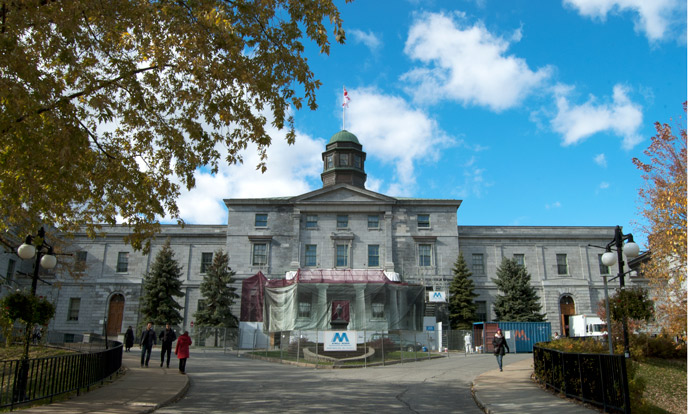Students walking past the Arts Building will continue to see the familiar face of construction, as the portico stabilization project has been delayed by two months.
When the project began in late June, the McGill Reporter wrote that it would cost around $500,000. According to Michael Mannella, project manager for the stabilization, however, the total project budget is $1.047 million.
“The project is still well under budget,” Mannella said. “In every construction project we undertake at the university, we always build in a 10 per cent construction contingency to deal with unknown site conditions. As it looks now, the construction contingency will be more than enough to deal with the [unforeseen circumstances] needed throughout the duration of the project.”
According to Mannella, the construction was meant to be completed this month, but has faced multiple setbacks. These include delays in masonry stone procurement and the need to find a stone supplier after the original supplier backed out of the project.
“Optimistically, we wanted to finish the project in October 2015,” he said. “With a building structure of [around] 100 years of age you are almost certain to come across site conditions and unknowns that need to be dealt with during the construction phase [….] With that said, we are now scheduled to be completed in early December, 2015.”
This project is one component of McGill’s efforts to tackle its massive infrastructure and maintenance deficit. Hudson Meadwell, interim dean for the Faculty of Arts, who has been at McGill for 25 years, attributed the lack of maintenance in the past to budgetary constraints.
“If the budget envelope [had been] bigger, we could accommodate more attention to deferred maintenance,” he said.
To address this issue, the university has committed to investing $400 million into deferred maintenance.
Structural problems were first identified in 2011 during a project to update the windows and facade of the Arts Building.
“The structural engineer installed a monitor on the cracks [then] in order to check for movement in the future,” Mannella said. “There was a small movement noticed on the monitors by the structural engineer in July 2014, which forced McGill Facilities to […] address the portico’s structural issues.”
Following further observations, consultants noticed that the portico entrance was beginning to pull away from the main building.
“This basically became a health and safety issue that needed to be dealt with as soon as possible,” Mannella said. “Also, the existing masonry elements were in advanced state of deterioration and needed to be either replaced or stabilized [….] Worst case scenario, if we would have ignored this problem […] the portico entrance would have simply detached completely from the main building structure.”
The Arts Building, one of the most iconic symbols of McGill, is defined as a ‘historically protected’ building, a status which affects restoration and renovation procedures.
“These are standards that are city-imposed or provincially-imposed with regards to particular buildings that are designated as heritage buildings,” explained Meadwell. “Because we as a campus have such a special connection to the city and to the mountain, there are lots of ways in which how we build is affected by distinctive kinds of restrictions.”
Mannella noted that this designation made the project more difficult and costly to complete.
“Our intention in this project was always to restore and stabilize the existing masonry elements rather than to replace them,” Mannella said. “It would have been easier and probably cheaper to just replace every masonry stone, but we definitely would not get the same quality of stone or colour match that it is needed [….] It is more expensive to maintain the authenticity, but you cannot put a dollar amount on the value we are adding to preserve the existing masonry elements.”
According to Associate Dean of Arts (Academic Administration and Oversight) Gillian Lane-Mercier, the increased emphasis on addressing deferred maintenance is due to evolving standards.
“Norms have changed over time,” she said. “What was fine in the 1960s is no longer fine with regards to ventilation and fire protections, and I think this has all added up on the part of the university that this deferred maintenance can’t be deferred [any longer].”









